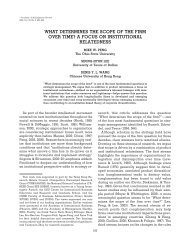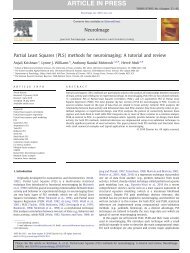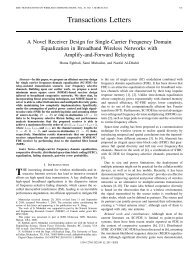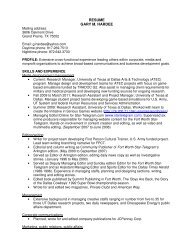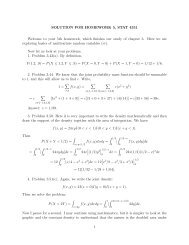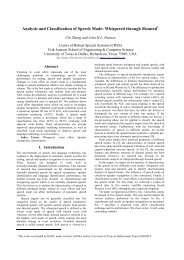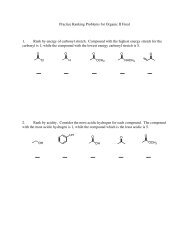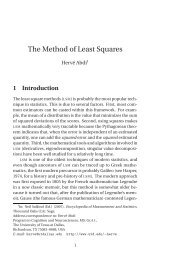Curriculum Vitae - The University of Texas at Dallas
Curriculum Vitae - The University of Texas at Dallas
Curriculum Vitae - The University of Texas at Dallas
You also want an ePaper? Increase the reach of your titles
YUMPU automatically turns print PDFs into web optimized ePapers that Google loves.
4. Adaptable Real-time Distributed Object Management for Command and Control Systems,Proceedings <strong>of</strong> the IEEE Intern<strong>at</strong>ional Symposium on Autonomous De-centralized Systems(ISADS) Conference, March 1999, Tokyo, Japan (co-authors: J. Maurer, R. Ginis, R. Freedman,M. Squadrito, S. Wohlever). Lead AuthorMy Contribution: This is a MITRE Team effort. <strong>The</strong> principal members <strong>of</strong> the design teamincluded John Maurer (Principal Investig<strong>at</strong>or), Peter Krupp, and myself. <strong>The</strong> others carried out theimplement<strong>at</strong>ion. I wrote the entire paper from the technical reports.5. Real-time CORBA, IEEE Transactions on Parallel and Distributed Systems, October 2000 (coauthors:V. Fay-Wolfe, L. DiPippo, G. Cooper, R. Johnston, P. Kortmann). Co-AuthorMy Contribution: I conceived the idea <strong>of</strong> real-time CORBA in 1994. Since then MITRE,<strong>University</strong> <strong>of</strong> Rhode Island and the Navy carried out the design together with the OMG standardsteam. <strong>The</strong> paper was a team effort. Much <strong>of</strong> the writing was carried out by the <strong>University</strong> <strong>of</strong> RI..6. Inform<strong>at</strong>ion Survivability for Real-time Command and Control Systems, IEEE Transactions onKnowledge and D<strong>at</strong>a Engineering, January 1999 (co-author: J. Maurer). Lead AuthorMy Contribution: I was the main designer <strong>of</strong> the system described in this paper and wrote thepaper. John Maurer (the project leader) gave comments on this paper.7. Dependable and Secure TMO Scheme, Proceedings IEEE Intern<strong>at</strong>ional Symposium on Object-Oriented Real-Time Distributed Computing (ISORC 2006) (co-author: J. Kim). Lead AuthorMy Contribution: I worked on the design <strong>of</strong> the system with my student Mr. Kim. My studentcarried out the implement<strong>at</strong>ion. I wrote the paper from my student’s MS <strong>The</strong>sis.17.4 SEMANTIC WEB, WEB SERVICES AND SECURITYI began my research on XML Security in December 1998 when I visited the <strong>University</strong> <strong>of</strong> Milan researchgroup to exchange ideas. I initi<strong>at</strong>ed a research project with this group led by Pr<strong>of</strong>. Bertino on securingXML documents. Two students worked on the project, one on access control and authentic public<strong>at</strong>ion <strong>of</strong>XML documents and the other on privacy and trust for XML documents. Subsequently when I joined NSFin October 2001, I continued with my research on securing the secure semantic web by exploring alllayers <strong>of</strong> the semantic web technology stack. Th<strong>at</strong> same month I particip<strong>at</strong>ed in an NSF-EU workshop <strong>at</strong>Sophia Antipolis and gave a present<strong>at</strong>ion on securing the semantic web technologies. This was the firstsuch present<strong>at</strong>ion on the topic. A major part <strong>of</strong> my current research is in this area.XML Security: Paper #1 (IEEE Transactions on Knowledge and D<strong>at</strong>a Engineering) describes myresearch with the <strong>University</strong> <strong>of</strong> Milan group on XML security. We developed an approach for controllingaccess to XML documents as well as to securely publish XML documents <strong>at</strong> the third party site. Wefocused on authenticity and completeness <strong>of</strong> the query responses. This approach has been recommendedfor secure d<strong>at</strong>a outsourcing. Paper #2 (ACM Transactions on Inform<strong>at</strong>ion and Systems Security) describesprivacy problems th<strong>at</strong> could occur due to the specific<strong>at</strong>ion <strong>of</strong> trust policies. In particular, we developed asecurity model, privacy-enhanced trust management algorithms and a pro<strong>of</strong> <strong>of</strong> concept prototype <strong>of</strong> thealgorithms.RDF Security and Inference Control: Paper #3 (Computer Standards and Interface Journal) describesthe various security standards for semantic web. It describes XML security, RDF security and security forontologies. <strong>The</strong>n I started focusing on securing RDF. My work on RDF security was novel <strong>at</strong> th<strong>at</strong> timeand I collabor<strong>at</strong>ed with pr<strong>of</strong>essors <strong>at</strong> the <strong>University</strong> <strong>of</strong> Insubria and together we developed securityarchitecture for RDF documents. This research was published in Paper #4 (DEXA conference workshop).Paper #5 (IFIPTM) continues with RDF security. In this paper, together with students I jointly supervisedwith another pr<strong>of</strong>essor <strong>at</strong> <strong>The</strong> <strong>University</strong> <strong>of</strong> <strong>Texas</strong> <strong>at</strong> <strong>Dallas</strong>, instead <strong>of</strong> explicitly coming up with accesscontrol for RDF documents, we use the Reific<strong>at</strong>ion principle already in RDF to control access to variousparts <strong>of</strong> the document. For example, we can make reific<strong>at</strong>ion st<strong>at</strong>ements <strong>of</strong> an RDF document such as“John has access to the RDF document”. This way we can use the reasoning capabilities in RDF tomanage security. Paper #6 (IFIP D<strong>at</strong>a Security Conference) makes a significant contribution to the106



